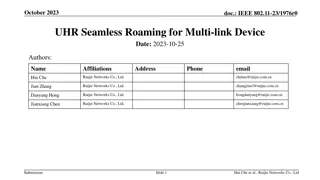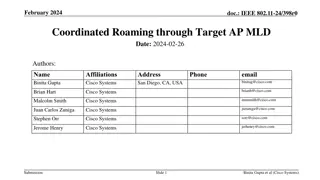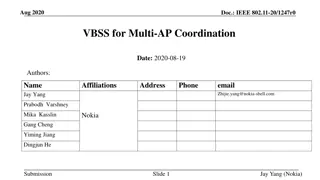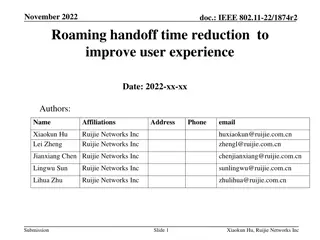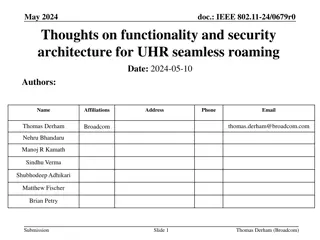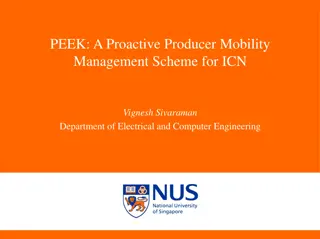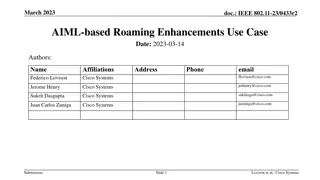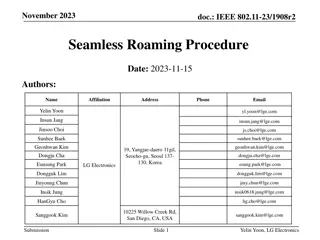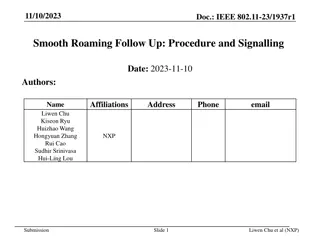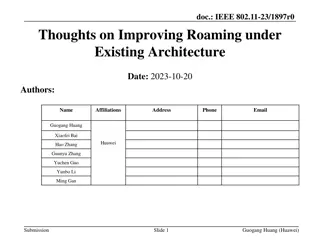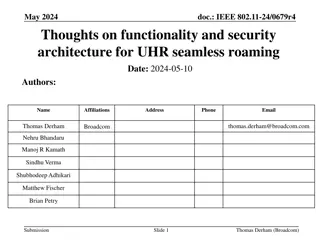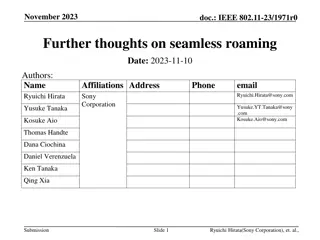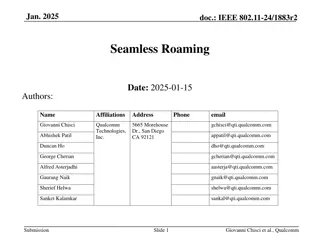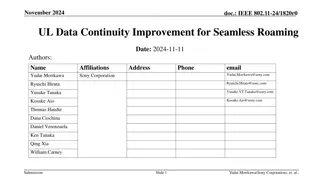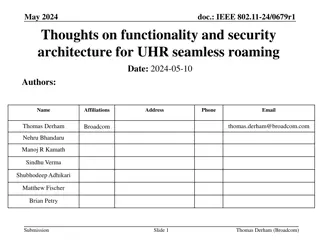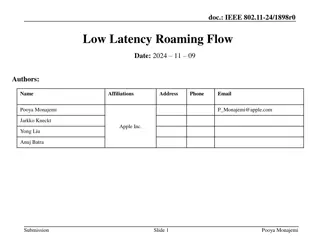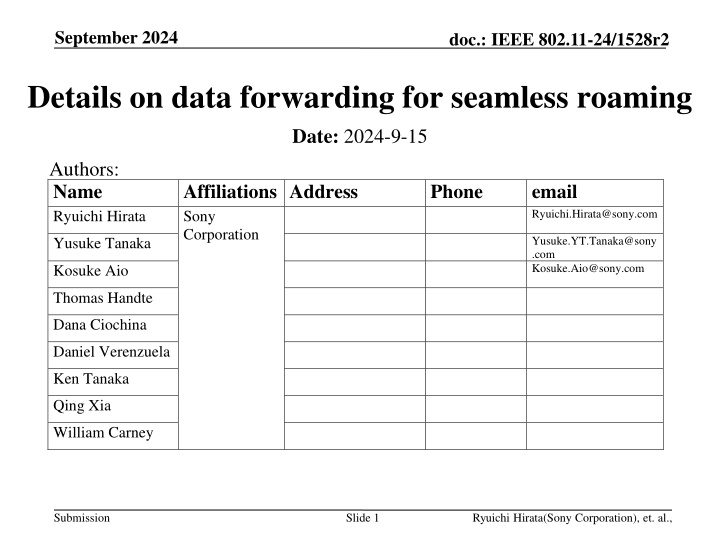
Details on Data Forwarding for Seamless Roaming in September 2024
Explore the IEEE 802.11-24/1528r2 document focusing on data forwarding for seamless roaming, discussing factors impacting DL data forwarding, roaming procedures, and the importance of buffered DL data forwarding. Considerations for DL data forwarding availability are highlighted, covering factors like backhaul conditions and network architecture.
Download Presentation

Please find below an Image/Link to download the presentation.
The content on the website is provided AS IS for your information and personal use only. It may not be sold, licensed, or shared on other websites without obtaining consent from the author. If you encounter any issues during the download, it is possible that the publisher has removed the file from their server.
You are allowed to download the files provided on this website for personal or commercial use, subject to the condition that they are used lawfully. All files are the property of their respective owners.
The content on the website is provided AS IS for your information and personal use only. It may not be sold, licensed, or shared on other websites without obtaining consent from the author.
E N D
Presentation Transcript
September 2024 doc.: IEEE 802.11-24/1528r2 Details on data forwarding for seamless roaming Date: 2024-9-15 Authors: Name Ryuichi Hirata Affiliations Address Sony Corporation Phone email Ryuichi.Hirata@sony.com Yusuke.YT.Tanaka@sony .com Kosuke.Aio@sony.com Yusuke Tanaka Kosuke Aio Thomas Handte Dana Ciochina Daniel Verenzuela Ken Tanaka Qing Xia William Carney Submission Slide 1 Ryuichi Hirata(Sony Corporation), et. al.,
September 2024 doc.: IEEE 802.11-24/1528r2 Introduction TGbn agreed that the current AP MLD may forward DL data to the target AP MLD [1]. As we showed in a previous contribution[2], DL data forwarding is important to minimize the UL suspension duration during roaming. In this contribution, we see some factors need to consider in DL data forwarding. Submission Slide 2 Ryuichi Hirata(Sony Corporation), et. al.,
September 2024 doc.: IEEE 802.11-24/1528r2 Recap : Roaming procedure with single link In single link case, STA should not transmit UL to the target AP while receiving DL from the current AP. STA can transmit UL to the target AP and may switch back to receive DL from the current AP. However, this may cause DL data loss if the current AP transmits DL while STA is transmitting UL. In dual link case, STA can transmit UL to the target AP while receiving DL from the current AP. After the current AP completes buffered DL transmission, STA can start transmitting UL to the target AP. This causes longer UL suspension. Dropping buffered DL at the current AP could reduce this, but this causes DL data loss. STA Current AP Target AP UL DL z Add link with the target AP Current AP Current AP Roaming request may ack to Roaming request Context transfer DS mapping change suspension Roaming response Additional UL suspension Complete buffered DL transmission Delete link Target AP Target AP Submission Slide 3 Ryuichi Hirata(Sony Corporation), et. al.,
September 2024 doc.: IEEE 802.11-24/1528r2 Recap : Roaming procedure with single link with DL data forwarding With buffered DL data forwarding from the current AP to the target AP, STA does not need to wait for DL from the current AP and can start transmitting UL after a link with the target AP becomes enabled. In some cases, the current AP cannot forward all buffered data due to amount of buffered data, backhaul condition, etc. In such cases, selective DL data forwarding may be needed. The current AP can delete link with STA immediately after completing context transfer and DS mapping change. STA Current AP Target AP UL DL z Add link with the target AP Current AP Current AP Roaming request may ack to Roaming request Context transfer DS mapping change suspension Buffered data forwarding Roaming response Delete link Target AP Target AP Submission Slide 4 Ryuichi Hirata(Sony Corporation), et. al.,
September 2024 doc.: IEEE 802.11-24/1528r2 Discussion point for data forwarding Data forwarding availability depends on the following factors, and these factors can be static or dynamic. Backhaul condition(delay) which depends on backhaul congestion(dynamic) network architecture(static) type of backhaul(wired, wireless) If data may send via central controller, this may have additional backhaul delay and processing delay[5]. AP MLD may have a huge amount of data in its buffer(dynamic)[3] AP MLD Capability/implementation(static/dynamic) AP MLD may buffer DL data deep in the hardware.[4, 5] 1. 2. 3. Therefore, we need to check these factors and decide whether to forward and how to forward. Submission Slide 5 Ryuichi Hirata(Sony Corporation), et. al.,
September 2024 doc.: IEEE 802.11-24/1528r2 DL data forwarding preparation phase Before initiating roaming, APs check the data forwarding availability which depends on static factors. APs exchange some frames to measure backhaul condition(delay). For example, Measurement Request/Response frame can be used. APs exchange their capability information about network architecture, buffer implementation, etc. For example, these information can be included in FT Capability and Policy field of the MDE, new Link Reconfiguration element, etc. Based on measurement results and capability information, the current AP decides whether to perform data forwarding. STA Current AP Target AP Backhaul measurement and capability exchange Add link with the target AP Roaming request may ack to Roaming request Context transfer DS mapping change Buffered data forwarding Roaming response Delete link Submission Slide 6 Ryuichi Hirata(Sony Corporation), et. al.,
September 2024 doc.: IEEE 802.11-24/1528r2 DL data forwarding execution phase Since the status of the buffer and backhaul congestion change dynamically, it is advisable to check the status after the STA or the current AP initiates roaming. The current AP and the target AP measure backhaul condition at this phase by exchange of roaming request and response. They can also add their buffer status information in roaming request and response. Based on measurement results and buffer information obtained by roaming request and response, the current AP decides whether to forward and how to forward. The current AP may indicate STA about the amount of DL from the current AP and the target AP. STA Current AP Target AP Add link with the target AP Roaming request may ack to Roaming request Roaming request Roaming response Indication of DL from current AP and target AP Buffered data forwarding Roaming response Delete link Submission Slide 7 Ryuichi Hirata(Sony Corporation), et. al.,
September 2024 doc.: IEEE 802.11-24/1528r2 Target AP selection based on information related to data forwarding These information related to availability of data forwarding can be used to select target AP. If the STA or the current AP does not decide AP to roam, they can decide target AP based on data forwarding availability. The current AP measures backhaul condition between other APs and exchanges their information related to network architecture, buffer implementation, etc. Based on measurement results and obtained information, the current AP can decide candidate target AP(s) to roam for the STA. STA Current AP other APs Backhaul measurement Target AP selection Add link with the target AP Roaming request may ack to Roaming request Context transfer DS mapping change Buffered data forwarding Roaming response Delete link Submission Slide 8 Ryuichi Hirata(Sony Corporation), et. al.,
September 2024 doc.: IEEE 802.11-24/1528r2 Forwarding data selection These information can also be used to select data to forward. For example, if the backhaul delay is low, low-latency traffic may be sent by the target AP. Conversely, if backhaul delay is high, the current AP should handle it. If the STA lost its connection with the current AP (for example, due to sudden RSSI drop[6], current AP sleep, etc.), the STA cannot retrieve buffered DL data frames from the current AP. Therefore, the current AP needs to forward its buffered data as much as it can. STA Current AP Target AP Add link with the target AP Roaming request may ack to Roaming request Roaming request Roaming response Buffered data forwarding with data selection Roaming response Delete link Submission Slide 9 Ryuichi Hirata(Sony Corporation), et. al.,
September 2024 doc.: IEEE 802.11-24/1528r2 Summary Data forwarding between AP MLDs is important to mitigate UL suspension duration during roaming. We see that some factors need to be considered for data forwarding. We propose protocols to enable APs to check the availability of data forwarding. Submission Slide 10 Ryuichi Hirata(Sony Corporation), et. al.,
September 2024 doc.: IEEE 802.11-24/1528r2 SP1 Do you agree to define a mechanism in 11bn that enables AP MLD to check the availability of forwarding data between AP MLDs? How to set KPIs for checking availability is TBD. Submission Slide 11 Ryuichi Hirata(Sony Corporation), et. al.,
September 2024 doc.: IEEE 802.11-24/1528r2 SP2 Do you agree to define a mechanism in 11bn that enables AP MLD to collect static information related to availability of forwarding data between AP MLDs before request/response exchange that initiates notification of the DS mapping change from the current AP MLD to the target AP MLD? Static information includes backhaul delay, buffer implementation, network architecture, etc. Submission Slide 12 Ryuichi Hirata(Sony Corporation), et. al.,
September 2024 doc.: IEEE 802.11-24/1528r2 SP3 Do you agree to define a mechanism in 11bn that enables AP MLD to collect dynamic information related to availability of forwarding data between AP MLDs during roaming? Dynamic information includes backhaul congestion, buffer status of AP MLD, etc. Submission Slide 13 Ryuichi Hirata(Sony Corporation), et. al.,
September 2024 doc.: IEEE 802.11-24/1528r2 SP4 Do you agree to define a mechanism in 11bn that enables AP MLD to decide candidate target AP MLD(s) to roam based on availability of forwarding data between AP MLDs? Submission Slide 14 Ryuichi Hirata(Sony Corporation), et. al.,
September 2024 doc.: IEEE 802.11-24/1528r2 References [1] 24/0209r4, Specification Framework for TGbn [2] 24/1086r0, Data forwarding for seamless roaming, Ryuichi Hirata (Sony Corporation) [3] 24/0830r1, Improve roaming between MLDs follow up, Po-Kai Huang (Intel) [4] 23/2157r2, Seamless roaming within a mobility domain, Binita Gupta (Cisco Systems) [5] 24/0679r1, Thoughts on Functionality and Security Architecture for UHR Seamless Roaming, Thomas Derham (Broadcom) [6] 24/0398r0, Coordinated Roaming through Target AP MLD, Binita Gupta (Cisco Systems) Submission Slide 15 Ryuichi Hirata(Sony Corporation), et. al.,
September 2024 doc.: IEEE 802.11-24/1528r2 Appendix : KPIs for checking availability of data forwarding One example to check availability of data forwarding is to compare estimated time of data arrival from current AP and target AP. Estimated time of DL data arrival from current AP = Amount of data / throughput of link with current AP Estimated time of DL data arrival from target AP = Amount of data / throughput of link with target AP + backhaul delay + additional delay Backhaul delay is delay between MAC SAP of current AP and MAC SAP of target AP If ETA of data from target AP is earlier than ETA of data from current AP, current AP will choose to forward buffered DL data to target AP. Submission Slide 16 Ryuichi Hirata(Sony Corporation), et. al.,
September 2024 doc.: IEEE 802.11-24/1528r2 Appendix : KPIs for checking availability of data forwarding Amount of data How much data is buffered in current AP, it is known by current AP Throughput of each link Throughput of the link with current AP could be measured by roaming request. Throughput of the link with target AP may be measured/shared by target AP. Backhaul delay This could be measured by Ping, etc. If there are controller between current AP and target AP, it could be measured by CAPWAP response time between the access point and the switch. However, it is preferable to measure delay between MAC SAP of current AP and target AP. Additional delay How deeply data is buffered in current AP and order of data in target AP. These information could be shared by roaming request/ack. Submission Slide 17 Ryuichi Hirata(Sony Corporation), et. al.,

